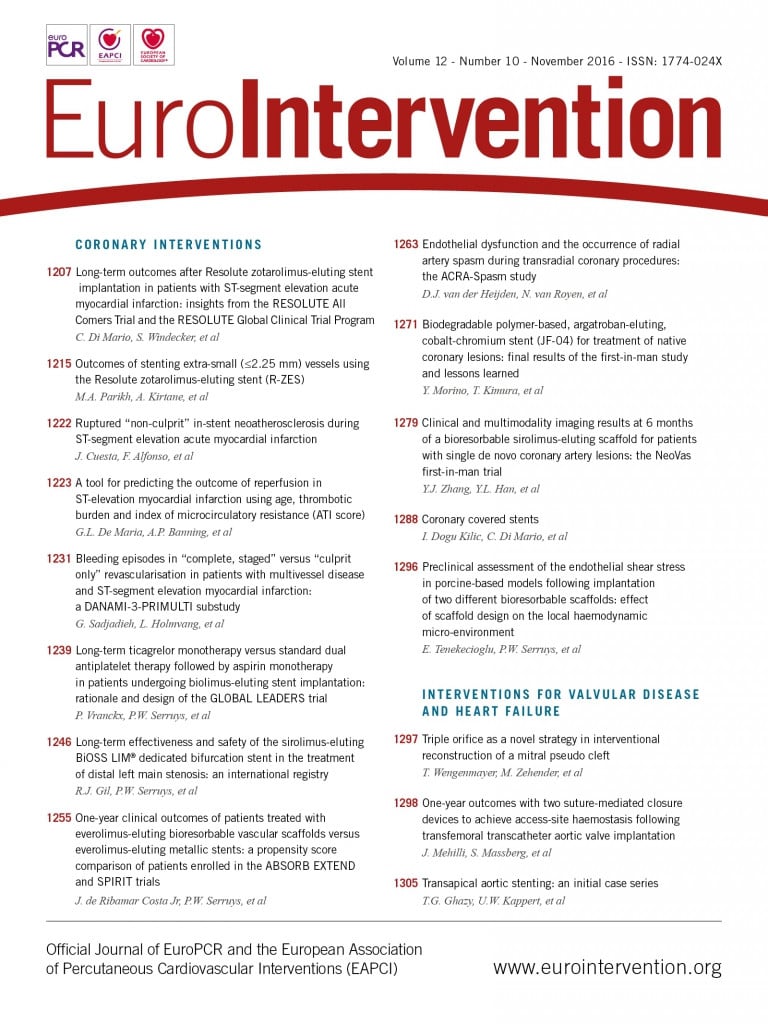

In vitro studies have demonstrated that stent implantation changes local haemodynamics as the protruding struts disturb the flow resulting in recirculation zones and low endothelial shear stress (ESS)1-3. Angiographic and OCT data were used to reconstruct 3D geometry of the right coronary artery of two healthy mini-swine implanted with 3.0×18 mm Absorb BVS (Abbott Vascular, Santa Clara, CA, USA) and 3.0×15 mm Mirage BRMS (Manli Cardiology Ltd., Singapore) (Online Figure 1). The angiographic data were used to estimate flow velocity4.
During the computational flow dynamic study, ESS was measured in the scaffolded segment around the circumference of the lumen per 5º interval and along the axial direction per 0.2 mm interval (cross-section). Mean ESS was lower in Absorb BVS compared to Mirage BRMS in steady flow simulation (0.60±0.51 Pa [n=5,256] vs. 1.09±0.76 Pa [n=6,336], respectively; p<0.001); 70% of the scaffolded surface in Absorb BVS and 53% in Mirage BRMS was exposed to a low (<1 Pa) athero-promoting ESS (Online Figure 1). The presented p-value is for hypothesis generation based on 5° subunit analysis (n=11,592) and needs cautious interpretation.
The difference in ESS may have arisen from strut geometry, strut thickness (Online Figure 2), alignment of the strut connectors, luminal diameter, vessel curvature and boundary conditions. In our case, after excluding other factors, lower ESS in Absorb BVS is potentially attributed to the flow disturbances caused by thicker rectangular struts (Panel A, Panel B, Panel C, Panel D, Online Figure 2). Longitudinal images (Panel A, Panel B) portray the flow patterns and ESS distribution during steady (Panel C, Panel D) and pulsatile (Panel E, Panel F) models; flow streamlines were taken at the highest velocity point in diastole. While recirculation zones were noted in proximal/distal regions of Absorb BVS (Panel C, Panel E), there was no recirculation in Mirage BRMS (Panel D, Panel F, Moving image 1, Moving image 2).
OCT-based reconstruction provides in vivo assessment of the effect of different scaffold designs on local haemodynamics and can be useful in optimising scaffold design.
Guest Editor
This paper was guest edited by Peter Barlis, MBBS, MPH, PhD, FCSANZ, FACC, FRSA, FRACP, FESC, Faculty of Medicine, Dentistry & Health Sciences, The University of Melbourne, Melbourne, Victoria, Australia.
Funding
E. Tenekecioglu has received a research grant from TUBITAK (The Scientific and Technological Research Council of Turkey).
Conflict of interest statement
P.W. Serruys and Y. Onuma are members of the International Advisory Board of Abbott Vascular. The other authors have no conflicts of interest to declare. The Guest Editor has no conflicts of interest to declare.
Supplementary data
Moving image 1. Pulsatile flow simulation in Absorb BVS.
Moving image 2. Mirage BRMS. It is obvious that the different strut design has an impact on the flow velocity which is reduced in the surface of the Absorb BVS.
Supplementary data
To read the full content of this article, please download the PDF.
Pulsatile flow simulation in Absorb BVS.
Mirage BRMS. It is obvious that the different strut design has an impact on the flow velocity which is reduced in the surface of the Absorb BVS.

